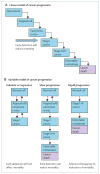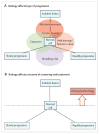Addressing overdiagnosis and overtreatment in cancer: a prescription for change
- PMID: 24807866
- PMCID: PMC4322920
- DOI: 10.1016/S1470-2045(13)70598-9
Addressing overdiagnosis and overtreatment in cancer: a prescription for change
Abstract
A vast range of disorders--from indolent to fast-growing lesions--are labelled as cancer. Therefore, we believe that several changes should be made to the approach to cancer screening and care, such as use of new terminology for indolent and precancerous disorders. We propose the term indolent lesion of epithelial origin, or IDLE, for those lesions (currently labelled as cancers) and their precursors that are unlikely to cause harm if they are left untreated. Furthermore, precursors of cancer or high-risk disorders should not have the term cancer in them. The rationale for this change in approach is that indolent lesions with low malignant potential are common, and screening brings indolent lesions and their precursors to clinical attention, which leads to overdiagnosis and, if unrecognised, possible overtreatment. To minimise that potential, new strategies should be adopted to better define and manage IDLEs. Screening guidelines should be revised to lower the chance of detection of minimal-risk IDLEs and inconsequential cancers with the same energy traditionally used to increase the sensitivity of screening tests. Changing the terminology for some of the lesions currently referred to as cancer will allow physicians to shift medicolegal notions and perceived risk to reflect the evolving understanding of biology, be more judicious about when a biopsy should be done, and organise studies and registries that offer observation or less invasive approaches for indolent disease. Emphasis on avoidance of harm while assuring benefit will improve screening and treatment of patients and will be equally effective in the prevention of death from cancer.
Copyright © 2014 Elsevier Ltd. All rights reserved.
Conflict of interest statement
KWK is a cofounder of Inostics and Personal Genome Diagnostics (PGDx), owns stock, and is a member of their scientific advisory boards. KWK is entitled to a share of royalty and milestone payments received by the Johns Hopkins University on sales of licenced inventions including some related to screening. These relationships are subject to certain restrictions under the Johns Hopkins University policy, and the terms of these arrangements are managed by the university in accordance with its conflicts of interest policies. All other authors declare that they have no competing interests.
Figures



Comment in
-
Addressing overdiagnosis and overtreatment in cancer.Lancet Oncol. 2014 Jul;15(8):e306-7. doi: 10.1016/S1470-2045(14)70247-5. Lancet Oncol. 2014. PMID: 24988932 No abstract available.
-
Addressing overdiagnosis and overtreatment in cancer.Lancet Oncol. 2014 Jul;15(8):e307. doi: 10.1016/S1470-2045(14)70295-5. Lancet Oncol. 2014. PMID: 24988934 No abstract available.
References
-
- Esserman L, Shieh Y, Thompson I. Rethinking screening for breast cancer and prostate cancer. JAMA. 2009;302:1685–92. - PubMed
-
- Shibata D. Cancer. Heterogeneity and tumor history. Science. 2012;336:304–05. - PubMed
-
- Lindstrom LS, Karlsson E, Wilking UM, et al. Clinically used breast cancer markers such as estrogen receptor, progesterone receptor, and human epidermal growth factor receptor 2 are unstable throughout tumor progression. J Clin Oncol. 2012;30:2601–08. - PubMed
Publication types
MeSH terms
Grants and funding
LinkOut - more resources
Full Text Sources
Other Literature Sources
Medical

